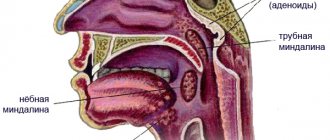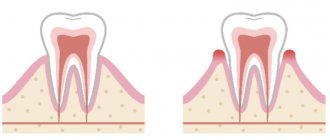28.06.2017
Head and neck diseases | Oropharynx and face
Hypertrophy is the growth of tissue. This reaction of the body serves as a response to increased stress on the organ. The most “physiological” example is muscle hypertrophy in weightlifters and bodybuilders. An enlarged liver often indicates intoxication of the body; proliferation of left ventricular tissue - the need to compensate for circulatory disorders caused by lung diseases, hypertension, etc.
Hypertrophy of the palatine tonsils (or tonsils) in most cases indicates that “attacks” on the main entrance gates of the body (mouth and nose) are so intense and frequent that the “personnel” of the “protective garrison” can no longer cope and asks for reinforcements.
The palatine tonsils are part of the immune organ - the lymphadenoid pharyngeal ring. They contain both the birth of new protective cells - lymphocytes (some of them perform their service “in place”, others enter the bloodstream and become available to the body), as well as the formation of very accurate and effective means of neutralizing the “enemy” - antibodies (especially in childhood). Elsewhere in the body, a similar role is played by the spleen, lymph nodes, and intestinal lymphoid tissue (including the appendix).
The palatine tonsils, it turns out, are also involved in digestion in the oral cavity: they contain enzymes that break down various food components.
Causes and course of the disease
Hypertrophic changes in the tonsils are considered as an immunoreactive condition that occurs when the body adapts to changing conditions and mobilizes compensation that has arisen in the lymphoid pharyngeal ring.
This is facilitated by breathing through the mouth, which is caused by hypertrophy of the adenoids, especially in the cold season. If adenoiditis provokes the formation of mucus, which forms in the nasal cavity, infects the palatine tonsils. Hyperplasia (increased cell proliferation) is promoted by infectious diseases and repeated inflammation in the oropharynx and nasal cavity.
Also, this process is influenced by poor living conditions, insufficient nutrition, as well as other factors that can reduce immunity. The size of the tonsils is affected by various disorders in the endocrine system, especially hypofunction (weakening of activity) of the adrenal cortex, exposure to small doses of radiation over a long period of time, hypovitaminosis (lack of vitamins).
The basis for too large an increase in the lymphoid tissue of the tonsils is the active proliferation (proliferation of tissue by cell multiplication) of immature T-lymphocytes and T-helper deficiency, which does not allow the production of full-fledged antibodies. The immunopathological predisposition of the child’s body to lymphatic diathesis, which is caused by hereditary deficiency of the lymphoid system, is influenced. Allergic reactions also influence the formation of hypertrophy of the palatine tonsils.
However, do not forget that hyperplasia is a reversible process. During adolescence, involution (reverse development) of lymphoid tissue occurs.
Hypertrophy of the palatine tonsils is often combined with a pathological enlargement of the entire pharyngeal lymphadenoid ring, especially often with hypertrophy of the pharyngeal tonsil (adenoids). Enlarged palatine tonsils generally have a dense and fairly elastic consistency, but in some cases they are spread out and soft on palpation. The palatine tonsils have no signs of inflammation and are not fused to the palatine arches. They have a developed lower pole and a triangular fold below, and the lacunae have a normal structure.
From a histological point of view, there is a predominance of hyperplasia of lymphoid tissue, in which there is an increase in the area of the follicles and the number of mitoses (indirect division), but plasma cells and macrophages are absent.
Hypertrophy of the palatine tonsils has 3 degrees:
- 1st degree - the palatine tonsils occupy 1/3 of the distance from the arch to the center of the pharynx (if measured along the midline of the pharynx);
- 2nd degree – already 2/3 of the distance mentioned above;
- 3rd degree – the tonsils are almost touching.
A microscopic examination reveals a large number of follicles with very frequent areas of mitosis, which indicates a very high activity of lymphoid tissue.
Friends! Timely and correct treatment will ensure you a speedy recovery!
Adenoid hypertrophy: treatment
At the first stage of treatment, the doctor determines the tactics - to be treated on an outpatient basis or to prepare for surgical removal. If adenoids interfere with breathing, prevent sleep, cause breathing apnea during sleep, or cause complications - hearing loss, damage to the cardiovascular system, kidneys - consider the possibility of surgery. If there is evidence, you shouldn’t be afraid of her. In case of exacerbation of chronic diseases, in the acute period of infections, blood clotting disorders, severe heart diseases, surgery is contraindicated. We are ready to organize treatment, including surgery, in clinics in St. Petersburg or partner clinics abroad, in Finland, Switzerland, Austria, and accompany patients from the first visit to recovery. Even grade 1 adenoid hypertrophy must be treated. At the second stage of treatment, if conservative methods are indicated, the doctor prescribes drugs - antiviral, antibacterial, antiallergic. Plus, local procedures are carried out to cleanse the nasal cavity of mucus and physiotherapy. It is important to restore the immune function of the adenoids. This is carried out by qualified doctors. You should not interfere with the functioning of the immune system yourself. At the third stage of treatment, the doctor evaluates the effect and adjusts the therapy. Follow the rules:
- avoid provoking factors - cold drinks, dust, air polluted by industrial emissions and tobacco smoke,
- humidify the air and ventilate more often,
- take a walk in the fresh air
- Avoid contact with people with colds.
At the fourth stage of treatment, the doctor determines the frequency of follow-up examinations and studies in order to monitor the condition and notice a relapse in time.
What result should I expect?
- Nasal breathing is normalized,
- Nasal discharge stops,
- Snoring disappears
- The frequency of viral infections is reduced,
- The general condition improves - vigor and energy appear, memory and attention improve.
Prevention of adenoid hypertrophy in children and adults
- Reduce the infectious load,
- Treat ARVI - you should not take a child who has not fully recovered to school or kindergarten,
- Moisturize the nasal cavity with saline solutions,
- Humidify the air in the apartment,
- Ventilate more often
- Give your child enough to drink
- Avoid contact with aggressive substances, including tobacco smoke,
- Strengthen your immune system: less stress and TV and computer, more fresh air and physical activity. Plus proper nutrition.
All these activities improve local immunity, which means they reduce the likelihood of “catching” a virus or bacteria. And then you won’t have to search for “adenoid hypertrophy symptoms and treatment” in a search engine.
Clinical picture
Hypertrophied palatine tonsils have a pale pink color, a smooth surface, clearly defined lacunae and a loose consistency.
They protrude somewhat beyond the edges of the anterior palatine arches. Patients complain of coughing, difficulty swallowing and breathing. There may be a speech disorder that occurs due to changes in the upper resonator, as a result of which the voice becomes nasal. Make an appointment right now!
Call us by phone or use the feedback form
Sign up
Due to brain hypoxia (oxygen starvation), patients sleep very restlessly at night, insomnia and night cough are possible. As a result of relaxation of the pharyngeal muscles, attacks of obstructive apnea (temporary cessation of breathing during sleep) may occur. Due to tubular dysfunction (the initial stage of dysfunction of the system), hearing impairment occurs, and the formation of exudative otitis media (ear inflammation) is possible.
Hypertrophy of the palatine tonsils in children
Often patients are children aged 5 to 7 years with a complicated history of adenoiditis. In such cases, both tonsillectomy and adenoid removal are performed as part of one intervention. The postoperative stage requires you to follow a diet. Food should be non-irritating, gentle, without adding seasonings. The drink is warm.
You can call an ENT doctor at home or make an appointment with a doctor through the form on the website or by calling the clinic. The doctor will examine the throat and, if hypertrophy is diagnosed, prescribe treatment.
The operation can also be performed on an outpatient basis. In this case, it is necessary to ensure constant monitoring of the patient, which is carried out until the final healing of the wound.
Treatment
If there are complaints of difficulty swallowing and breathing, cough, or speech disorders, it is recommended to partially remove the tonsils (tonsillotomy) when the child reaches 5-7 years of age.
But such an operation has the following contraindications: acute infectious diseases, blood diseases, diphtheria bacilli carriage. Tonsillotomy is not recommended for polio outbreaks. ENT surgery can be performed on an outpatient or inpatient basis, both under anesthesia and local anesthesia. It is not uncommon to perform a bilateral tonsillectomy - complete removal of the tonsils.
Causes and symptoms of chronic tonsillitis
If general immunity is reduced and/or the body has had to face a powerful infectious attack (for example, a sore throat or infection with herpes viruses), a real battle between the immune system and microbes unfolds in the lacunae of the tonsils. As a result, pus, consisting of dead microbes and cells (purulent-caseous plugs), accumulates in the lacunae. Tonsils clogged with pus stop working as an immune organ , and pathogenic microbes thrive in the purulent contents of the lacunae and multiply. These are the so-called plugs in the tonsils. At this stage of the process, it is enough to wash the tonsils from pus and provide a little help to the immune system, after which the normal function of the tonsils is restored.
Chronic tonsillitis, tonsil in section. 1 – lacunae of the tonsil. 2 – the entrance to the lacuna is blocked by a purulent plug. 3 – entrance to a clean lacuna. On the right - vacuum rinsing of the tonsils - a painless and quick procedure. 8-10 seconds - and the plugs are washed with a disinfecting solution.
Symptoms of chronic tonsillitis:
- Painful sensations in the throat area
- Enlarged lymph nodes
- Bad breath
- Sometimes there are headaches
- Sometimes there is discomfort in the ears
- The waste products of microbes from the tonsils enter the bloodstream , poisoning the body (tonsillogenic intoxication); hence fatigue, pain in muscles and joints, headaches, decreased mood, and even, in some cases, a prolonged increase in body temperature;
- Tonsils become a reservoir of infection , from where it can spread throughout the body and cause inflammatory processes (acne, cystitis, prostatitis, adnexitis, dysbacteriosis, inflammation of the paranasal sinuses, etc.);
- Bad breath - it is caused by organic substances decomposing in the gaps; 4. The tonsils stop working as an immune organ , immunity decreases, and the slightest provocation (hypothermia, overwork, stress) can “finish off” the immune system and open the way for germs.
Diagnostics
- Anamnesis collection, visual examination and palpation of the mucous membranes of the floor of the mouth, the anterior two-thirds of the tongue, the tonsils and base of the tongue, the mucous membrane of the palate, cheeks and gums, and the posterior wall of the pharynx.
- Diagnosis of HPV infection: immunohistochemical determination of the surrogate marker p16 in tumor tissue.
- Computed tomography of the chest and abdominal cavity to exclude metastatic lesions.
- Biopsy – cancer can be diagnosed only by taking a tissue sample from a growth that is suspicious for a malignant process.
- MRI of the soft tissues of the neck provides more accurate detail of the soft tissues compared to CT. Performed to assess the prevalence of the process.
- Ultrasound of the lymph nodes of the neck to determine their structure (if there is metastasis in the lymph nodes, they may not change their size, but the structure of the lymph node changes).
- PET-CT may be ordered if occult distant metastases are suspected in some situations.
- Fibercolonoscopy, fibrogastroduodenoscopy, laryngoscopy and some other studies may also be prescribed.
HPV-associated squamous cell carcinoma of the right tonsil (A) demonstrating p16 overexpression by immunohistochemistry (B) and evidence of high-risk HPV by in situ hybridization (C). Patients with HPV-related tonsil squamous cell carcinoma rarely harbor oncogenic HPV infection at other pharyngeal sites, SelvamThavaraj et all., ELSEVIER April 2014
Determination of stage
Determination of the stage of cancer is carried out according to the TNM system (T - tumor, N - nodulus, M - metastasis), including the size of the primary tumor, the spread of tumor cells to regional (located next to the primary tumor) lymph nodes and to distant areas (lungs, liver) . Today, the Russian Federation has adopted the seventh classification of tumors (the newest is the eighth). The connection between tonsil cancer and HPV infection is also taken into account during staging (but only for the eighth classification) - with similar morphological data of the tumor and its distribution, the stage of tonsil cancer associated with HPV infection is often lower, in contrast to cancer associated with other factors . In general, the prognosis for tonsil cancer associated with HPV infection is more favorable.
Tonsil cancer staging based on tumor size is “T”. headandneckcancerguide.org
Why is chronic tonsillitis dangerous?
Chronic tonsillitis is dangerous due to its complications associated with the spread of infection throughout the body. We often see that after treating tonsillitis, our patients are no longer bothered by all sorts of chronic diseases and allergies. The most severe complications of tonsillitis are rheumatism and severe kidney damage - glomerulonephritis. Toxins produced by some microbes tend to damage ligamentous and cartilage tissues, cause inflammation, as well as pain in joints and muscles.
How chronic tonsillitis affects the heart. Heart valve prolapses and heart rhythm disturbances are common findings when examining the heart in patients suffering from chronic tonsillitis. The fact is that the protein of beta-hemolytic streptococcus group A, which often parasitizes the tonsils, is similar to the protein of the connective tissue of the human heart and joints. Therefore, response aggression of the immune system is possible not only against streptococcus, but against one’s own heart and joints.
Chronic tonsillitis and allergies. Sometimes one course of treatment for tonsillitis is enough for allergic rashes, itching and even attacks of bronchial asthma to “magically” go away. The fact is that the long-term presence of an infectious focus in the tonsils not only reduces immunity, but also distorts its reactivity, causing allergic changes.
Complications of treatment
Indeed, there are two directions in the treatment of tonsil cancer with the same outcome, but different techniques: surgical treatment and radiation therapy. It is important to note that these approaches will have different complications.
Radiation therapy may be complicated by bone or soft tissue necrosis and swallowing problems, especially in patients with advanced tonsil cancer. Myelitis, trismus, hypoglossal nerve damage, and long-term risk of another malignancy are also possible.
Complications of surgery include difficulty swallowing, fistula formation, failure of flap healing, poor wound healing, and aspiration of food and saliva, sometimes leading to laryngectomy. The risk of severe and/or fatal complications after surgery is higher than with radiation therapy.
Complications of systemic therapy include fatigue, skin toxicity, mucositis, diarrhea, hepatotoxicity, pneumonitis, hypo- and hyperthyroidism, myelotoxicity, neuropathies, metabolic disorders, etc.










